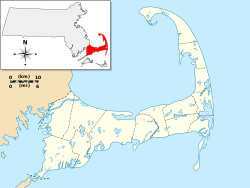
Nobska Light, originally called Nobsque Light, also known as Nobska Point Light is a lighthouse located near the division between Buzzards Bay, Nantucket Sound, and Vineyard Sound in the settlement of Woods Hole, Massachusetts on the southwestern tip of Cape Cod, Massachusetts. It overlooks Martha's Vineyard and Nonamesset Island. The light station was established in 1828, with the tower protruding above the keeper's house, and was replaced in 1876 by the current 42 foot tall iron tower. The light station was added to the National Register of Historic Places as Nobska Point Light Station in 1987.
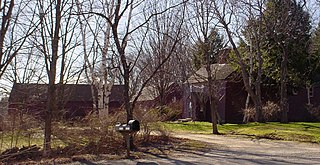
The John Sedgley Homestead is a historic homestead property at Scituate and Chases Pond Road in the York Corner area of York, Maine. Its oldest structure built in the late First Period, probably c. 1715, it is the oldest homestead in the State of Maine that is still in its original setting. Historically the homestead included a cape, farm home, carriage house, stables building, two outbuildings, and a large land holding, all of which is still existing today. The property was listed on the National Register of Historic Places in 1976.

The Middleborough Waterworks are historic waterworks on E. Grove St. at Nesmasket River and Wareham St. at Barden Hill Road in Middleborough, Massachusetts. The 1885 masonry pumphouse is one of the earliest public water works buildings in southeastern Massachusetts. It, and the well from which it pumps water, were built by the local fire district. The building has Queen Anne styling; the well itself is covered by an octagonal roof with cupola.

The Foxborough Pumping Station is a historic water pumping station at 25 Pumping Station Road in Foxborough, Massachusetts. Its main pumphouse was designed by Ernest N. Boyden, a regionally known architect of water supply systems, and was built in 1891; it is a brick structure with Queen Anne styling. The station also includes several historic wells, a period garage, and the man-made Fales Pond, a once-dammed section of the Neponset Reservoir near the pumphouse. The station was listed on the National Register of Historic Places in 2005.

The Teaticket School is a historic former school building at 340 Teaticket Hwy in Falmouth, Massachusetts. Built in 1927, this large Colonial Revival building was the first consolidated elementary school in the town. It has since 1967 served as the Administration Building for the Falmouth Public Schools. It was listed on the National Register of Historic Places in 2002.

The Methuen Water Works is a historic water works building on Cross Street in Methuen, Massachusetts. Built in 1893 or soon thereafter, it was one of the city's first major public works project. The surviving building, designed by Ernest N. Boyden, is a distinctive local example of Romanesque architecture. It was listed on the National Register of Historic Places in 1984. It now houses offices of the city's water department.

Walka Water Works is a heritage-listed 19th-century pumping station at 55 Scobies Lane, Oakhampton Heights, City of Maitland, New South Wales, Australia. Originally built in 1887 to supply water to Newcastle and the lower Hunter Valley, it has since been restored and preserved and is part of Maitland City Council's Walka Recreation and Wildlife Reserve. It was added to the New South Wales State Heritage Register on 2 April 1999.

The Metropolitan District Commission Pumping House is a historic water pumping station, adjacent to Spot Pond in the Middlesex Fells Reservation, on Woodland Road in Stoneham, Massachusetts. Built in 1901 by the Metropolitan District Commission (MDC), it is one of Stoneham's finest examples of Renaissance Revival architecture. The building was listed on the National Register of Historic Places in 1984, and included in the Middlesex Fells Reservoirs Historic District in 1990.

The House at 380 Albion Street in Wakefield, Massachusetts is one of the finest Bungalow/Craftsman style houses in the town. It was built c. 1910 in a then-rural part of Wakefield that been annexed from Stoneham in the 1880s. The house was listed on the National Register of Historic Places in 1989.

The British Engineerium is an engineering and steam power museum in Hove, East Sussex. It is housed in the Goldstone Pumping Station, a set of High Victorian Gothic buildings started in 1866. The Goldstone Pumping Station supplied water to the local area for more than a century before it was converted to its present use. The site has been closed to the public since 2006, and in March 2018 the entire complex was put up for sale.

Canelo Ranger Station, also known as Canelo Work Station, is a historic ranger station in the Coronado National Forest, within Santa Cruz County of southern Arizona. It is located in the ghost town of Canelo, within a small valley between the Canelo Hills on the west and the northern Huachuca Mountains on the east.

The City of Beloit Waterworks and Pump Station was built in 1885 in Beloit, Wisconsin just below a hill on top of which sits the Beloit Water Tower. It was added to the National Register of Historic Places in 1990.

New Pump-House, also known as the Byrd Park Pump House, is a historic pumping station building located in Byrd Park, Richmond, Virginia. It was built in 1881–1883, and is a three-part, "I" plan, Gothic Revival style granite building. A one-story, L-shaped annex was built in 1905. The building features a steeply pitched roof, projecting gables, Gothic arches, and lancet windows. Also on the property are the contributing Beaux Arts style 1924 Hydro Electric Pumping Station constructed of brick, concrete, and stucco and the 1881 Worthington Steam Pump Building, a one-story Italianate style pump house built of brick coated with stucco. The complex was built as the waterworks for the city of Richmond.

The Wiregrass Museum of Art is an art museum in Dothan, Alabama. The museum was founded in 1988 and is located in the city's former power and water plant. The building was listed on the Alabama Register of Landmarks and Heritage in 1990 and the National Register of Historic Places in 1991.

Grand Mound Town Hall and Waterworks Historic District, also known as Hose house, pump house, is a historic district located in Grand Mound, Iowa, United States. It was listed on the National Register of Historic Places in 2001. The district is composed of two buildings and the town's water tower.
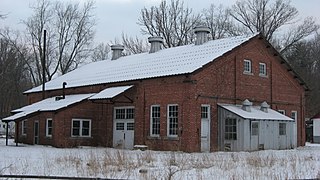
Tide Water Pumping Station, also known as Benton Station and SOHIO Pumping Station, is a historic pumping station complex and national historic district located in Harrison Township, Clay County, Indiana. The complex includes the 1+1⁄2-story, brick gale roofed pump house (1915); frame warehouse; a metal shed; two Queen Anne style dwellings; a metal garage; a concrete sluice and bridges; and the remains of a tennis court, dam and pond, and buried pipes. It is one of 14 pumping stations built along a 546.16 mile oil pipeline built between Crawford County, Illinois and Rixford, Pennsylvania. The station closed about 1957.
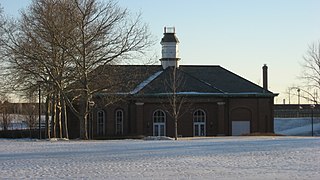
West Washington Street Pumping Station is a historic pumping station located in Indianapolis, Indiana. It was built in 1870, and is a one-story, rectangular brick building. It was modified to its present form after 1909, and is 2/3 of its original size. It has a slate hipped roof topped by a square central tower and features distinctive brick detailing, and arched openings. The building served as the city's only water pumping station until 1890.

The Huning Highlands Conoco Service Station is a historic gas station in the Huning Highlands neighborhood of Albuquerque, New Mexico. It was built in 1937 by the Continental Oil Company (Conoco) and is notable as a well-preserved example of the automobile-oriented development that shaped the city during the mid-20th century. The building was listed on the New Mexico State Register of Cultural Properties and the National Register of Historic Places in 2006.
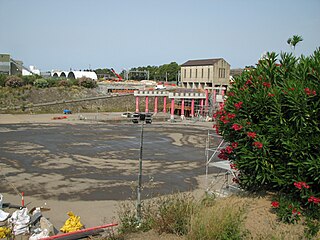
Sydenham Pit & Drainage Pumping Station 1 is a heritage-listed pumping station and stormwater drain in Garden Street, Marrickville, Inner West Council, Sydney, New South Wales, Australia. The facility is located adjacent to the railway line running between Sydenham railway station and St Peters railway station. It was designed by the NSW Public Works Department, which built the project from 1935 to 1941. It is also known as Sydenham Stormwater Basin and Drainage Pumping Station (DPS1). The property is owned by Sydney Water. It was added to the New South Wales State Heritage Register on 15 November 2002.

Ernest N. Boyden (1852–1918) was an American architect in practice in Boston from 1875 until his death in 1918.

